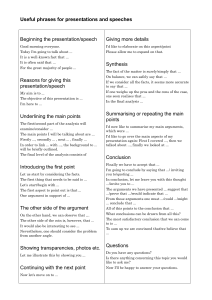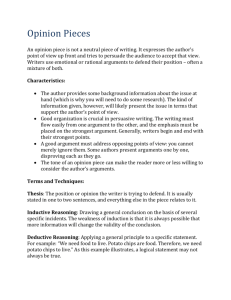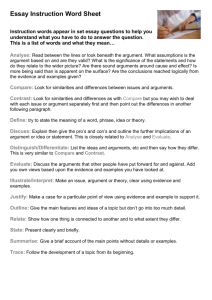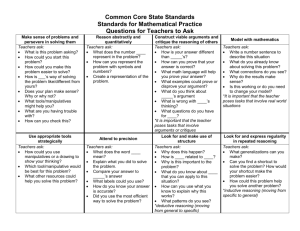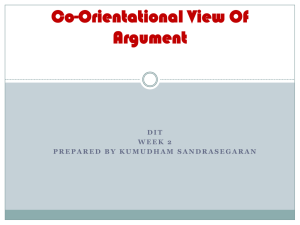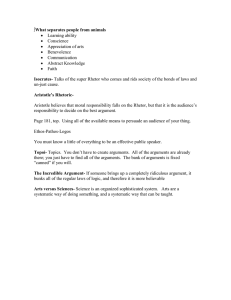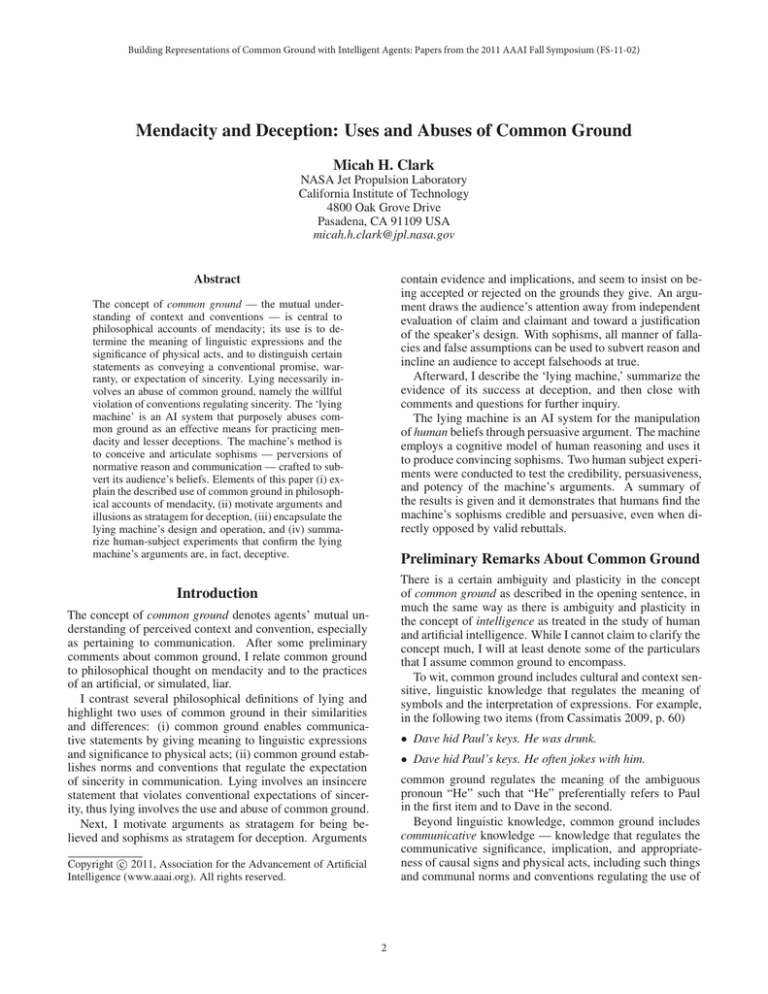
Building Representations of Common Ground with Intelligent Agents: Papers from the 2011 AAAI Fall Symposium (FS-11-02)
Mendacity and Deception: Uses and Abuses of Common Ground
Micah H. Clark
NASA Jet Propulsion Laboratory
California Institute of Technology
4800 Oak Grove Drive
Pasadena, CA 91109 USA
micah.h.clark@jpl.nasa.gov
contain evidence and implications, and seem to insist on being accepted or rejected on the grounds they give. An argument draws the audience’s attention away from independent
evaluation of claim and claimant and toward a justification
of the speaker’s design. With sophisms, all manner of fallacies and false assumptions can be used to subvert reason and
incline an audience to accept falsehoods at true.
Afterward, I describe the ‘lying machine,’ summarize the
evidence of its success at deception, and then close with
comments and questions for further inquiry.
The lying machine is an AI system for the manipulation
of human beliefs through persuasive argument. The machine
employs a cognitive model of human reasoning and uses it
to produce convincing sophisms. Two human subject experiments were conducted to test the credibility, persuasiveness,
and potency of the machine’s arguments. A summary of
the results is given and it demonstrates that humans find the
machine’s sophisms credible and persuasive, even when directly opposed by valid rebuttals.
Abstract
The concept of common ground — the mutual understanding of context and conventions — is central to
philosophical accounts of mendacity; its use is to determine the meaning of linguistic expressions and the
significance of physical acts, and to distinguish certain
statements as conveying a conventional promise, warranty, or expectation of sincerity. Lying necessarily involves an abuse of common ground, namely the willful
violation of conventions regulating sincerity. The ‘lying
machine’ is an AI system that purposely abuses common ground as an effective means for practicing mendacity and lesser deceptions. The machine’s method is
to conceive and articulate sophisms — perversions of
normative reason and communication — crafted to subvert its audience’s beliefs. Elements of this paper (i) explain the described use of common ground in philosophical accounts of mendacity, (ii) motivate arguments and
illusions as stratagem for deception, (iii) encapsulate the
lying machine’s design and operation, and (iv) summarize human-subject experiments that confirm the lying
machine’s arguments are, in fact, deceptive.
Preliminary Remarks About Common Ground
There is a certain ambiguity and plasticity in the concept
of common ground as described in the opening sentence, in
much the same way as there is ambiguity and plasticity in
the concept of intelligence as treated in the study of human
and artificial intelligence. While I cannot claim to clarify the
concept much, I will at least denote some of the particulars
that I assume common ground to encompass.
To wit, common ground includes cultural and context sensitive, linguistic knowledge that regulates the meaning of
symbols and the interpretation of expressions. For example,
in the following two items (from Cassimatis 2009, p. 60)
Introduction
The concept of common ground denotes agents’ mutual understanding of perceived context and convention, especially
as pertaining to communication. After some preliminary
comments about common ground, I relate common ground
to philosophical thought on mendacity and to the practices
of an artificial, or simulated, liar.
I contrast several philosophical definitions of lying and
highlight two uses of common ground in their similarities
and differences: (i) common ground enables communicative statements by giving meaning to linguistic expressions
and significance to physical acts; (ii) common ground establishes norms and conventions that regulate the expectation
of sincerity in communication. Lying involves an insincere
statement that violates conventional expectations of sincerity, thus lying involves the use and abuse of common ground.
Next, I motivate arguments as stratagem for being believed and sophisms as stratagem for deception. Arguments
• Dave hid Paul’s keys. He was drunk.
• Dave hid Paul’s keys. He often jokes with him.
common ground regulates the meaning of the ambiguous
pronoun “He” such that “He” preferentially refers to Paul
in the first item and to Dave in the second.
Beyond linguistic knowledge, common ground includes
communicative knowledge — knowledge that regulates the
communicative significance, implication, and appropriateness of causal signs and physical acts, including such things
and communal norms and conventions regulating the use of
c 2011, Association for the Advancement of Artificial
Copyright Intelligence (www.aaai.org). All rights reserved.
2
signs and acts. For example, it is common ground in the culture of the United States that a kiss on the cheek is a natural
sign of intimacy not to be given to strangers, while in, say,
Italian, French and Hispanic cultures, it is a conventional
sign of greeting appropriate for cordial introduction.
Common ground also includes procedural knowledge of
communication, that is to say, knowledge of “how to” communicate. For example, common ground enables a mother to
use language, affect, and intonation in such a way as to communicate to her children that her question, “Is your room
clean?” is both sincere inquiry and demand for obedience.
As the latter part of this paper concerns arguments, I note
that arguments are also the purview of common ground;
at a minimum, common ground determines the linguistic
form for argumentation and establishes the dialogical “rules”
for disputation (for review of formal accounts, see Prakken
2006). However, it is unclear if standards of argument (i.e.,
epistemological warrant) are constructs of convention and
thus in the realm of common ground. Further comments on
this topic are deferred to the conclusion.
4. The speaker must act intending to deceive the audience
with respect to the stated proposition. (intent to deceive
addressee condition)
Both traditional and non-traditional accounts generally
agree with the first three conditions. That is to say, they
generally agree that lying necessarily involves an insincere
statement by one and to another. This is of interest because
stating something has everything to do with common ground.
To state something to another implies propositional knowledge and procedural competence regarding a communal language (more accurately, it implies belief that one has these).
For illustration, a definition of stating follows.
L states p to D =df (1) L believes that there is an expression E and a language S such that one of the standard
uses of E in S is that of expressing the proposition p;
(2) L utters E with the intention of causing D to believe that he, L, intended to utter E in that standard use.
(Chisholm and Feehan 1977, p. 150)
In this definition, we find beliefs about a shared understanding of language. Specifically, we find beliefs about the standard usage and meaning of expressions (clause 1) and about
the significance of utterances (clause 2). Such beliefs are
constituents of common ground.
The disputed fourth condition pertains to the fact that not
all insincere statements are lies. For example, actors do not
lie when playing roles, comedians do not lie when being
sardonic, and friends do not lie when stating falsely while
signaling facetiousness with a wink. With traditional accounts, the approach to ruling out such cases is to require
an intent to deceive (condition 4) and then to point out its
absence in these cases. Depending on the author, the intent to deceive may be with respect to the stated proposition p, the higher-level proposition “the speaker accepts p,”
the proposition “the speaker is being sincere,” or all three
(see, e.g., Chisholm and Feehan 1977; Simpson 1992). Such
considerations lead to the issue of how it is known that the
speaker should to be taken as expressing a truth, or at least
his own belief — that is to say, to the issue of how sincerity is
made known. The traditional conception is that a speaker’s
sincerity is conveyed by solemnity and that solemnity can
be described as something akin to a promise or obligation
of sincerity. When one solemnly states, one promises (is
obligated, etc) to be sincere. It is relatively common for traditional definitions to strengthen condition 1 such that lying
requires a solemn statement (sometimes called an assertion).
Solemnity is of interest because it is a construct of convention and its establishment is a matter of common ground. In
order to state solemnly, one must adhere to the appropriate
communal norms and conventions for solemnity given the
context. The corollary is that the solemnity of a statement
cannot be determined independent of common ground. In
most linguistic communities, solemnity is normative. Outside of special contexts (e.g., play-acting) and absent specific signs and signals (e.g., a wink, a nod, or a wave of the
hand), statements are presumed solemn. However, solemnity is not a universal norm. Barnes (1994, pp. 70–72) details a community wherein statements are presumed nonsolemn, thus specific signs and signals are needed to indi-
Uses of Common Ground in
Philosophical Accounts of Lying
Common ground appears in the philosophical literature on
lying in the form of a linguistic community’s shared knowledge, norms, and conventions. In definitions of lying, common ground is the basis for the meaning and significance of
linguistic acts and it establishes the conventions regulating
expectations and acceptable behavior. Indeed, lying may be
nothing more than an intentional violation of certain mutually recognized conventions set forth as common ground.
In this section I contrast what I call “traditional” and “nontraditional” accounts of lying and point out the use of common ground in their similarities and differences (nuanced or
overly technical points of contention are not taken up; for
review, see Mahon 2008a; 2008b). The traditional accounts
are loosely those that require an intent to deceive, and are
called “traditional” because this intent has been a customary necessary condition since late antiquity (for exemplars,
see St. Augustine, De Mendacio; Aquinas, Summa Theologica, II–II, Q. 110; Siegler 1966; Chisholm and Feehan 1977;
Kupfer 1982; Williams 2002). The non-traditional accounts
reject the necessity of an intent to deceive.
Using L and D to denote the speaker (i.e., the liar) and the
hearer (i.e., the would-be deceived), a straw man, traditional
definition of lying follows.
L lies to D =df L states a proposition p to D while believing that p is false and intending to deceive D with
respect to p.
Following along the analysis of Mahon (2008a), this putative
definition contains four necessary conditions:
1. The speaker must make a statement. (statement condition)
2. The statement must be made to another — an intended
audience. (addressee condition)
3. The statement must be insincere. That is to say, the
speaker must believe the statement is false. (insincerity
condition)
3
Arguments as Stratagem for Being Believed
cate solemnity. I prefer to describe solemnity as a presumptive expectation, or right of convention, based on common
ground. When one solemnly states, one believes that the audience has a presumptive expectation of sincerity.
Some reject the necessity of an intent to deceive (e.g., Carson 2006; Sorensen 2007; Fallis 2009) and offer counterexamples such as lies told with the intent of flaunting the truth.1
Yet, in general, such critics still affirm the determinate role
of common ground — through either solemnity or a similar construct of convention. For example, Carson (2006)
employs the idea of a “warranty of truth” and argues that a
willful violation of this warranty is sufficient for lying. His
non-traditional definition follows.
The remainder of this paper concerns a machine that simulates lying by proffering disingenuous, sophistic arguments.
Before describing the machine, I briefly discuss the speculative rationale for the machine’s argumentative method.
Ordinarily, liars and truth-tellers alike have in common an
intent to be believed — to have their statements accepted as
true, or at least sincere. When their statements are of sufficient simplicity (e.g., innocuous, non-argumentative statements such as, “I did not eat the last cookie”) statement content only plays a small part in being believed. That is to say,
for innocuous statements an audience’s grounds for belief
lie outside a statement’s content, not within; it is based on
such things as reputation, reliability, and warranty of truth.
Figuratively speaking, an audience may ask themselves:
A person S tells a lie to another person S1 iff: 1. S
makes a statement x to S1, 2. S believes that x is false or
probably false (or, alternatively, S doesn’t believe that
x is true), 3. S states x in a context in which S thereby
warrants the truth of x to S1, and 4. S does not take herself to be not warranting the truth of what she says to
S1. (Carson 2006, n. 29; italics added)
Is the speaker’s statement solemn — is it to be taken
seriously? Does she have a reputation of honesty? Has
she often been right before — is she reliable? Is she
knowledgeable or an authority in the topic? Does her
statement conflict with what I already believe I know?
What might be her reason for belief? Do I have a opinion or emotional response to speaker or statement that
inclines me to accept or reject either?
Carson (2006) writes that the “warranty of truth” is a kind of
guarantee or promise that what one says is true, that it is context and convention that dictate if one warrants the truth of
one’s statement or not, and that these factors make it impossible to precisely state necessary and sufficient conditions
for warranting the truth of a statement.
Fallis (2009) removes all obfuscation of common ground.
He writes that when one solemnly states or asserts, one says
something while believing that Grice’s (1989) first maxim
of quality is in effect as a norm of conversation. (Of course,
common ground is what regulates whether or not the first
maxim of quality is in effect.) Fallis’ non-traditional definition of lying follows and can be characterized as a willful
violation of the aforementioned norm of conversation.
In such questions, content is little used because innocuous,
non-argumentative statements contain neither the evidence,
the inference, nor the imperative for belief.
In contrast, arguments contain evidence and implications
supporting an ultimate claim, and arguments seem to insist
that the claim be accepted or rejected on the grounds given.
Arguments function as a form of demonstration (cf. Aristotle, Rhetoric, 1.1 1355a) — they have the appearance (but
not always the substance) of demonstrable justification that
belief is warranted. For illustration, consider the argumentative denial: “No, I did not eat the last cookie, Jane did. Go
and see the crumbs on her blouse before she brushes them
off.” At first blush, the argument appears to be more than just
a denial and accusation; it offers in one hand the promise of
corroborating evidence, and in the other, an abductive explanation for the absence of evidence. Whether this argument
has any objective strength over the non-argumentative statement, “No, I did not eat the last cookie, Jane did,” is a matter
of epistemological analysis, which is subject to standards of
common ground. The point of the illustration is that an argument draws an audience’s attention away from independent
evaluation of claim and claimant and toward a justification
of the speaker’s design.
Just as good evidence and arguments can convince us of
facts that would otherwise seem preposterous (e.g., quantum
theory, Gödel’s incompleteness theorems), so also all manner of fallacies and false assumptions can be used to subvert
reason and incline an audience to erroneously accept falsehoods at true. Were it the case that humans faithfully applied
normative standards, fallacious arguments would only injure
the speaker by revealing him and his position as either foolish or false. But alas, this is not the case. In a litany of
studies going back to the seminal works of Wason (1966)
and Tversky and Kahneman (1974), humans are abysmally
bad at normative reasoning and rational judgment.
You lie to X if and only if: (1) You state that p to X.
(2) You believe that you make this statement in a context where the following norm of conversation is in effect: Do not make statements that you believe to be
false. (3) You believe that p is false. (Fallis 2009, p. 34)
In the final analysis, it matters little if one uses solemnity, a warranty of truth, or a Gricean maxim, all three are
constructs of convention and are established via common
ground. It is common ground that regulates the communal
standards for mandatory sincerity, and speakers make themselves subject to the mandates of common ground when they
voluntarily participate as members of a linguistic community. Lying necessarily involves a knowing disregard of the
communal standards for sincerity. These standards are coercive — no promise is needed to make them obligatory, nor
moral to make them justified. To lie is to simply break “the
rules” regulating statements of personally held beliefs.
1
For example, a thief who knows that she cannot be punished
unless she admits her wrongdoing might lie and deny the accusation while intending everyone to know that it was she who did it.
4
• A fallacious argument for a true proposition (an expedient
fiction for the fraudulent conveyance of a truth)
• A fallacious argument for a false proposition (the most
opprobrious form being one that insidiously passes from
true premises to a false conclusion)
The lying machine’s anticipatory, psychological model is
based on a variant of Johnson-Laird’s (1983; 2006) mental
models theory. The theory aims “to explain all sorts of thinking about propositions, that is, thoughts capable of being
true or false” (Johnson-Laird 2005, p. 185), and the theory
claims that the mental representations produced by perceptual and linguistic comprehension are demonstrative models
and reasoned beliefs, choices, and actions supervene on their
manipulation. Accordingly, a mental model is an iconic, parsimonious, and internally coherent, affirmative representation of a way the world (e.g., the world around us, the world
of natural numbers, the world of Narnia) might be.2 Comprehension and deliberation are processes wherein mental
models are constructed, inspected, and manipulated based
on semantic content and on perceptual and linguistic context. These processes eventuate a set of mental models that,
taken together, captures the conclusive understanding.
Crucially, a mental model is not a perfect imitation of the
world. A model represents facets of the world inasmuch as
they are affirmed and are relevant to the cognizer’s present
task and domain; whatever is false, superficial, or irrelevant
is ignored or quickly forgotten. The models are rendered parsimonious by internal mechanisms that compensate for these
omissions during inspection and manipulation. This form of
parsimony is not without loss of information, and it gives
rise to systemic biases and illusions (see, e.g., Johnson-Laird
and Savary 1996; 1999; Johnson-Laird et al. 2000; Yang and
Johnson-Laird 2000; Khemlani and Johnson-Laird 2009).
A variant of mental models theory is integrated into the lying machine via a mental models calculus for propositional
reasoning. The calculus provides a set-theoretic account of
mental models-theoretic concepts and operations, and its semantics is defined in terms of partial Boolean functions. The
calculus is used to anticipate an audience’s understanding
of linguistic statements and to transform premises and presumed beliefs into corresponding sets of mental models.
Rather than simulate a psychological model of deliberation, argument construction is constituted as a tractable
graph-theoretic problem, namely that of finding a least-cost
hyperpath in a weighted hypergraph (Gallo et al. 1993).
Each node in the hypergraph is a set of mental models and
each hyperarc is a either the operation of combining two sets
of mental models (a form of semantic conjunction) or the operation of observing that one set of mental models subsumes
another (a form of direct inference). The hypergraph contains nodes for each initial premise and is closed under the
two previously mentioned operations. Thus, the hypergraph
is understood to represent possible lines of reasoning emanating from a initial set of premises, and each hyperpath represents an argument for a particular conclusion. With this in
A Sketch of the Lying Machine
I hold that sophistic arguments are effective means for mendacity and lesser deceptions. My approach to the practice of
sophistry is to exploit highly fallible heuristics and biases by
incorporating so-called cognitive illusions (Pohl 2004) into
arguments. This approach reflects the twin empirical facts
that (i) many humans are, unknowingly, imperfect reasoners
who predictably succumb to a host of biases and illusions,
and (ii) many humans are supremely, yet undeservedly, overconfident of their ability to reason and to judge reasoning.
The ‘lying machine’ (Clark 2010) was built to test my approach to sophistry. It is an AI system for the manipulation
of human beliefs through persuasive argument. The machine
employs a variant of mental models theory (Johnson-Laird
1983; 2006), a predictive theory of human reasoning. This
theory is used in the generation of credible arguments and
is integrated into the machine’s ascriptive theory about the
mental contents and operations of its audience.
By design, the lying machine maintains conceptually
separate repositories for its first- and second-order beliefs
(i.e., its beliefs about the world and its beliefs about its audience’s beliefs about the world). The machine reasons over
and about first-order beliefs in a normatively correct fashion
using a variety of machine reasoning techniques. When reasoning over and about second-order beliefs the machine uses
both normatively correct reasoning techniques and a mental
models theory. In so reasoning, the machine internally contrasts (i) what it believes, (ii) what it believes its audience
ought to believe were they to reason in a normatively correct fashion, and (iii) what it believes its audience will likely
believe given their predictable fallibility.
In operation, the lying machine seeks to achieve various
persuasion goals of the form “persuade the audience of X,”
where X is a proposition about the world. Given a persuasion goal of X the machine first forms its own justified belief
about X. That is to say, it determines and internally justifies
whether X follows from, or is excluded by, first-order beliefs (i.e., its own beliefs about the world). The machine
then determines whether the audience ought to believe X
and whether X can be justified in a convincing fashion based
solely on second-order beliefs (i.e., its beliefs about the audience’s beliefs). If so, the machine constructs a credible
argument for X and articulates it to the audience.
The lying machine’s arguments are credible in the perceptual sense (as opposed to normative logical or epistemological senses) of credibility. Its arguments may be classically
valid or invalid; the importance is that they appear valid according to the psychological theory at hand. Argument credibility is enhanced by limiting the initial premises to what the
audience is presumed to believe already. Since the machine
is not constrained by classical validity it is able to produce
all the following forms of argument.
• A veracious argument for a true proposition emanating
from shared beliefs
• A valid argument for a false proposition emanating from
one or more false premises that the audience erroneously
believes already
2
In other words, mental models are “analogical” (Sloman 1971)
or “homomorphic” (Barwise and Etchemendy 1995) representations (for review, see Selman 1998).
5
mind, the task of constructing a “credible” argument reduces
to discovering a “least-cost” hyperpath given an appropriate
weighting scheme. Hyperpaths are weighted to accord with
known predictors of inference difficulty (e.g., the number of
tokens in a mental model, the number of alternative mental models; see Johnson-Laird 1999). This scheme reflects
the hypothesis that argument credibility is closely related to
inference difficulty, and — for engineering convenience —
that inference difficulty can be used as a proxy for credibility. Furthermore, the properties of the weighting scheme are
such that least-cost hyperpath algorithms retain polynomialtime complexity (Ausiello et al. 1992). The described graphtheoretic, argumentation framework naturally supports composition and sub-graphing. These features can be used to
integrate additional, psychologically inspired heuristics for
argument generation (e.g., heuristics for enthymematic contraction, for forcing the use of specific lemmas, or for incremental level-of-detail refinement).
At least one of the following two statements is true:
1. If Stacy has a pair of scissors then she has a bottle of glue.
2. If Stacy has craft paper then she has a bottle of glue.
The following two statements are true:
3. If Stacy has a bottle of glue then she has a pack of tissues.
4. Stacy has a pair of scissors and craft paper.
————————–
Is it necessary that Stacy has a pack of tissues?
Figure 1: Sample control item
At least one of the following two statements is true:
1. If Tom has loose-leaf paper then he has a stapler.
2. If Tom has graph paper then he has a stapler.
The following two statements are true:
3. If Tom has a stapler then he has a staple remover.
4. Tom has loose-leaf paper or graph paper, and possibly both.
————————–
Is it necessary that Tom has a staple remover?
Results from Human Subject Experiments
The lying machine’s arguments were tested for credibility,
persuasiveness, and potency in two human subject experiments. In this section I describe the experiments and present
a summary of results (for detailed analysis, materials, etc,
see Clark 2010). The analysis shows that human subjects
find the machine’s sophisms credible and persuasive, even
when opposed by classically valid rebuttals.
Figure 2: Sample experimental item
Experiment 1
Experiment 1 used a 2 × 3 (item type × treatment) mixed design to assess argument credibility and persuasiveness. Subjects were assigned to one of three treatment groups, A, B,
or C. After exclusions, the group sizes were 24, 20, and 20.
Subjects in group A were asked to answer the aforementioned battery of items and to rate their confidence (7-point
Likert item, 1 indicating disagreement, 7 agreement, 4 neutrality).3 Subjects in groups B and C performed a slightly
different task. Using the ruse that they were viewing another
respondent’s reasoning and response, they were given each
item along with the item’s predicted response and an argument for that response (i.e., an argument for the correct answer on control items and for the incorrect answer on experimental items). They were asked: (i) to rate their agreement
with the argument (7-point Likert item), (ii) whether the item
was answered correctly, and (iii) to rate their confidence.
Treatment of groups B and C only differed in the provenance and reasoning of the arguments. The arguments presented to group B were manually created, preposterous arguments while the ones presented to group C were produced
by the lying machine (for a sample, see figure 3). These
groups contrast humans reasoning on their own (group A),
humans reasoning under the influence of ‘arbitrary’ arguments (group B),4 and humans reasoning under the influence
of arguments produced by the lying machine (group C).
The two main predictions were that groups A and B would
be similar, and that group C would be more accurate on
Materials, Procedures, Subjects, and Screening
The materials for both experiments were based on a single
battery of multi-step, ostensibly deductive, reasoning items.
Each item consisted of a small number of premises and a yesor-no question about what could be concluded. In addition,
each item was categorized as a control or as an experimental
item on the basis of whether it was predicted to elicit a logically correct or a logically incorrect response (this is a standard practice for experiments investigating mental models
and illusions). The battery consisted of four pairs of control
and experimental items where, in each pair, the control item
and experimental item had highly similar logical structures
but different linguistic presentations.Sample control and experimental items are shown in figures 1–2.
Both experiments were conducted over the Internet using
a web-based survey system. The survey system enforced
that items were answered in order and ensured that subjects
could not revisit previously answered items. Subjects had an
unlimited amount of time to complete the experiment. One
hundred undergraduates from Rensselaer Polytechnic Institute participated as subjects (seventy-five in experiment 1
and twenty-five in experiment 2).
Subjects were instructed not to consult outside resources
and were asked about this on a post-experiment questionnaire. The reported data excludes subjects who said they
used outside resources. It also excludes “I do not know” responses (one of the allowed responses to the yes-or-no questions). Because of this precautionary screening, item sample
size varied and, in experiment 1, treatment group size varied.
3
Related control and experimental items were separated by a
minimum of two items and, in half, the control was presented first.
4
By ‘arbitrary,’ I mean arguments whose reasoning is unrelated to mental models theory and contraposed to the psychological
model of argument employed by the lying machine.
6
Table 1: Summary of results for experiment 1 — accuracy, mean confidence, and mean agreement aggregated by group
Accuracy (N)
Mean Confidence (SD)
Mean Agreement (SD)
Group (N)
Control
Experimental
Control
Experimental
Control
Experimental
A (96)
B (80)
C (80)
81.3% (96)
82.3% (79)
93.2% (73)
60.4% (91)
50.7% (75)
25.0% (72)
6.13 (1.15)
6.03 (1.27)
6.34 (0.99)
5.99 (1.25)
5.92 (1.26)
6.19 (1.18)
NA
3.84 (2.37)
5.84 (1.66)
NA
2.71 (2.17)
5.04 (2.24)
Table 2: Summary of results for experiment 2 — accuracy, mean confidence, and mean agreement aggregated by item type
Mean Agreement (SD) with . . .
Item Type
Control
Experimental
Accuracy (N)
Mean Confidence (SD)
Valid Arguments
Invalid Arguments
91.8% (73)
37.1% (70)
6.01 (1.37)
6.04 (1.20)
6.17 (1.49)
3.37 (2.44)
1.83 (1.49)
4.63 (2.44)
Experiment 2
control items and less accurate on experimental items than
the other two groups (i.e., group C would be influenced by
the accompanying arguments). The experiment’s results are
summarized in table 1 and both predictions are borne out.
For control items, group C was more accurate than the others but the difference among groups is not significant (likely
due to the insensitivity of the Kruskal-Wallis test and the
high accuracy of groups A and B, which left little room for
significant improvement). For experimental items, group C
was less accurate and the difference among groups is significant (Kruskal-Wallis, χ2 = 14.591, d.f. = 2, p < 0.001).
As predicted, a multiple-comparisons analysis (Siegel and
Castellan 1988, pp. 213–214) indicates that this difference
is significant only between groups C and A (p = 0.05, obs.
diff. = 20.775, crit. diff. = 13.49529) and between groups C
and B (obs. diff. = 15.15, crit. diff. = 14.09537).
The overall effect on performance manifests as a widening of the gap in accuracy between control and experimental items (where a wider gap means a subject more often
selected the predicted or proffered response). The mean accuracy gaps for groups A, B, and C are 22.2%, 32.1%, and
68.3%. Thus, subjects given machine generated arguments
(group C) chose the proffered and predicted answer more
than twice as often as subjects in other treatment groups.
The difference among groups is significant (Kruskal-Wallis,
χ2 = 14.2578, d.f. = 2, p < 0.001), and is so only between groups C and A (p = 0.05, obs. diff. = 19.783333,
crit. diff. = 13.49529) and between groups C and B (obs.
diff. = 17.3, crit. diff. = 14.09537).
As for argument agreement, there are significant differences between groups B and C, with group B generally disagreeing and group C generally agreeing. In both
groups, agreement is highly correlated with accuracy gap
size (Spearman correlation, Z = 3.3848, p < 0.001). That
is to say, the more agreeable an argument, the more likely a
subject was to affirm its conclusion as correct.
Finally, there were no interactions with confidence and it
is uncorrelated with agreement and accuracy. Subjects were
very confident (overconfident, in fact) in all groups.
Experiment 2 used a within-subjects design to test whether
the effects observed in experiment 1 were due to the absence
of arguments for contrary positions and whether the machine
generated sophisms would remain persuasive (i.e., are potent) when set alongside valid rebuttals.
The experiment had twenty subjects after exclusions. Subjects were given the same battery of items as in experiment 1
but in this case each item was accompanied by two arguments, one for each answer. Subjects were asked (i) to rate
their relative agreement with one argument versus the other
(7-point Likert item), (ii) to choose the correct answer, and
(iii) to rate their confidence. Control items were accompanied by a machine generated, classically valid argument for
the correct response and a manually created, preposterous argument for the incorrect response. Experimental items were
accompanied by a machine generated, invalid argument for
the incorrect response (a sophism) and a manually created,
classically valid argument for the correct response. Sample
arguments are shown in figures 3–4.
If subjects recognize the certainty of classically valid arguments then the persuasiveness of the machine generated
sophisms ought to be countermanded. However, if the
sophisms are potent then subjects ought to prefer these invalid arguments (and incorrect answers) even in the face of
valid rebuttals. The experiment’s results are summarized in
table 2 and indicate that the illusory effects of the lying machine’s arguments persist even when rebutted.
Subjects had a wide gap in accuracy between control and
experimental items (54.8% mean; Wilcoxon, Z = 3.6609,
p < 0.001). In both item types, subjects preferred the machine generated arguments over the manually created arguments (Wilcoxon, Z = 3.2646, p ≈ 0.001). Agreement with
machine generated arguments is correlated with the accuracy gap size (Spearman correlation, Z = 2.5762, p < 0.01).
Finally, confidence levels remained high across item types,
which indicates subjects did not find one item type “harder”
than the other and were unaware that their reasoning biases
were being manipulated.
7
Either it is true that if Tom has loose-leaf paper then he has
a stapler, or it is true that if Tom has graph paper then he
has a stapler. So, if Tom has either loose-leaf paper or graph
paper then he has a stapler. Since it is true that Tom has
either loose-leaf paper or graph paper, it follows that he has
a stapler. Now according to statement 3, if Tom has a stapler
then he has a staple remover. Tom has a stapler and therefore
he has a staple remover. So yes, it is necessary that Tom has
a staple remover.
Next, with respect to arguments in general, it is unclear
whether epistemological warrant is a construct of convention. I do not mean to raise the specter of relativism; I simply ask whether the convictive force of argument is due to
innate appeal or conformance to conventional standards. I
admit that on the side of convention, different communities
certainly profess different epistemic standards: for example,
the communities of metaphysicists and philosophers of science versus the communities of empiricists and scientists.
However, I do not know that there is any great difference in
the standards guiding the ordinary conduct of their lives. To
settle the matter, some practical, psychological, or sociological account of warrant is needed.
Last, what things are not common ground? The treatment of reason, illusion, and warrant as tacitly contained in
my discussion of sophisms and the lying machine present
these elements as universals — normative either logically or
psychologically. Does common ground contain all kinds of
knowledge and belief which one agent may use when anticipating or interacting with others? Or is it that common
ground only contains the kind of knowledge that is contingent on implicit or explicit agreement? In my preliminary
remarks, I denoted some of the particulars that I assumed
common ground to encompass, but I did not indicate its
boundaries. I do not know where these boundaries lie.
Figure 3: Sample sophism for the item shown in figure 2
Suppose that Tom does not have a staple remover. According
to statement 3, if Tom has a stapler then he has a staple remover, so it follows that Tom does not have a stapler. Now,
either it is true that if Tom has loose-leaf paper then he has
a stapler, or it is true that if Tom has graph paper then he
has a stapler. If both statements are true then Tom has a stapler since, according to statement 4, he has either loose-leaf
paper or graph paper. This contradicts the earlier observation that Tom does not have a stapler. So, it is impossible that
both statements 1 and 2 are true. Now suppose that only statement 2 is true. Since if Tom has graph paper then he has a
stapler, and since Tom does not have a stapler, it follows that
Tom does not have graph paper. Tom has either loose-leaf paper or graph paper, so since Tom does not have graph paper,
he has loose-leaf paper. Therefore, it is possible that Tom has
only loose-leaf paper. So no, it is not necessary that Tom has
a staple remover.
Acknowledgments
I am indebted to Selmer Bringsjord, Joshua Taylor, and
two anonymous reviewers for insightful comments on this
manuscript. Special thanks to Sangeet Khemlani and Deepa
Mukherjee for advice on the design and conduct of the human subject experiments.
Figure 4: Sample rebuttal for the item shown in figure 2
Comments and Questions for Further Inquiry
Admittedly, mechanizing effectual means for mendacity is
controversial, and presentation of the lying machine invites
polemic attack and defense, but in keeping with this paper’s
purpose of relating common ground to mendacity and to
the machine’s sophistic practices, I confine my comments
to three issues of common ground.
First, the lying machine uses illusions of reasoning, and
the explanation given for the cause of these illusions followed the usual course and claims found in the literature
on mental models; namely, that certain incomplete mental
representations and processes underlie human reasoning and
that these give rise to illusions. For at least some illusions,
there may be an alternative explanation based on convention (i.e., common ground). In particular, key premises in
illusions involving inclusive and exclusive disjunctions are
structurally similar if not identical to argumentative statements of case-based reasoning. Read aloud, a premise such
as, “if there is a king in the hand then there is an ace, or
else if there isn’t a king in the hand then there is an ace”
(cf. Johnson-Laird and Savary 1999, p. 205) appears to express inference, not assertion (despite our being told that it
is a premise). Though there is not room here to fully develop
the idea, I wonder if, in following the lead of informal logic
and fallacy theory, an analysis of conversational maxims and
principles in deductive illusions might not yield an explanation based on linguistic convention and function; an explanation not predicated on a specific psychological theory.
References
Aquinas, T. [c. 1265–1274] 1948. Summa Theologica. New
York, NY: Benziger Brothers, revised, reissued edition.
Aristotle. [c. 350 BCE] 1823. Rhetoric. In Gillies, J., ed.,
A New Translation of Aristotle’s Rhetoric. London, England:
T. Cadell.
Ausiello, G.; Giaccio, R.; Italiano, G. F.; and Nanni, U.
1992. Optimal Traversal of Directed Hypergraphs. Technical Report TR-92-073, International Computer Science Institute.
Barnes, J. A. 1994. A Pack of Lies: Towards a Sociology of
Lying. Cambridge, England: Cambridge University Press.
Barwise, J., and Etchemendy, J. 1995. Heterogeneous Logic.
In Glasgow, J. L.; Narayanan, N. H.; and Chandrasekaran,
B., eds., Diagrammatic Reasoning: Cognitive and Computational Perspectives. Menlo Park, CA: AAAI Press. chapter 7, 211–234.
Carson, T. L. 2006. The Definition of Lying. Noûs
40(2):284–306.
Cassimatis, N. 2009. Flexible Inference with Structured
Knowledge through Reasoned Unification. IEEE Intelligent
Systems 24(4):59–67.
Chisholm, R. M., and Feehan, T. D. 1977. The Intent to
Deceive. Journal of Philosophy 74(3):143–159.
8
Clark, M. 2010. Cognitive Illusions and the Lying Machine: A Blueprint for Sophistic Mendacity. Ph.D. Dissertation, Rensselaer Polytechnic Institute, Troy, NY.
Fallis, D. 2009. What is Lying? Journal of Philosophy
106(1):29–56.
Gallo, G.; Longo, G.; Pallottino, S.; and Nguyen, S. 1993.
Directed hypergraphs and applications. Discrete Applied
Mathematics 42(2–3):177–201.
Grice, P. 1989. Studies in the Way of Words. Cambridge,
MA: Harvard University Press.
Johnson-Laird, P. N., and Savary, F. 1996. Illusory inferences about probabilities. Acta Psychologica 93(1–3):69–
90.
Johnson-Laird, P. N., and Savary, F. 1999. Illusory inferences: a novel class of erroneous deductions. Cognition
71(3):191–229.
Johnson-Laird, P. N.; Legrenzi, P.; Girotto, V.; and Legrenzi,
M. S. 2000. Illusions in Reasoning About Consistency. Science 288:531–532.
Johnson-Laird, P. N. 1983. Mental Models: Towards a Cognitive Science of Language, Inference, and Consciousness.
Cambridge, MA: Harvard University Press.
Johnson-Laird, P. N. 1999. Deductive reasoning. Annual
Review of Psychology 50(1):109–135.
Johnson-Laird, P. N. 2005. Mental Models and Thought. In
Holyoak, K. J., and Morrison, R. G., eds., The Cambridge
Handbook of Thinking and Reasoning. Cambridge, England:
Cambridge University Press. chapter 9, 185–208.
Johnson-Laird, P. N. 2006. How We Reason. New York,
NY: Oxford University Press.
Khemlani, S., and Johnson-Laird, P. N. 2009. Disjunctive
illusory inferences and how to eliminate them. Memory &
Cognition 37(5):615–623.
Kupfer, J. 1982. The Moral Presumption Against Lying.
The Review of Metaphysics 36(1):103–126.
Mahon, J. E. 2008a. The Definition of Lying and Deception.
In Zalta, E. N., ed., The Stanford Encyclopedia of Philosophy. Stanford, CA: Stanford University. URL: http:// plato.
stanford.edu/ archives/ fall2008/ entries/ lying-definition/ .
Mahon, J. E. 2008b. Two Definitions of Lying. International Journal of Applied Philosophy 22(2):211–230.
Pohl, R. F., ed. 2004. Cognitive Illusions: A handbook
on fallacies and biases in thinking, judgement and memory.
New York, NY: Psychology Press.
Prakken, H. 2006. Formal systems for persuasion dialogue.
The Knowledge Engineering Review 21(2):163–188.
Selman, B. 1998. Analogical Representations. In Pylyshyn,
Z. W., ed., Constraining Cognitive Theories: Issues and Options. Stamford, CT: Ablex Publishing. chapter 5, 61–84.
Siegel, S., and Castellan, N. John, J. 1988. Nonparametric Statistics for the Behavioral Sciences. New York, NY:
McGraw-Hill, 2nd edition.
Siegler, F. A. 1966. Lying. American Philosophical Quarterly 3(2):128–136.
Simpson, D. 1992. Lying, Liars and Language. Philosophy
and Phenomenological Research 52(3):623–639.
Sloman, A. 1971. Interactions Between Philosophy and
Artificial Intelligence: The Role of Intuition and NonLogical Reasoning in Intelligence. Artificial Intelligence
2(3–4):209–225.
Sorensen, R. 2007. Bald-Faced Lies! Lying Without the Intent to Deceive. Pacific Philosophical Quarterly 88(2):251–
264.
St. Augustine. [c. 395] 1847. De Mendacio. In Seventeen
Short Treatises of S. Augustine, Bishop of Hippo. Oxford,
England: John H. Parker. 382–425.
Tversky, A., and Kahneman, D. 1974. Judgment under Uncertainty: Heuristics and Biases. Science 185:1124–1131.
Wason, P. C. 1966. Reasoning. In Foss, B. M., ed., New
Horizons in Psychology. Hammondsworth, England: Penguin. 135–151.
Williams, B. A. O. 2002. Truth and Truthfulness: An Essay
in Genealogy. Princeton, NJ: Princeton University Press.
Yang, Y., and Johnson-Laird, P. N. 2000. Illusions in quantified reasoning: How to make the impossible seem possible,
and vice versa. Memory & Cognition 28(3):452–465.
9


